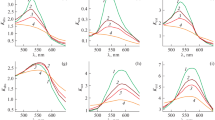Abstract
The shape of lines in the radiospectroscopic (NMR and EPR) and dielectric spectra of materials formed by nanoparticles (hereafter, nanomaterials) is analyzed theoretically. The theory is developed in the framework of the core and shell model according to which a nanoparticle consists of two regions whose properties are affected and unaffected by the surface, respectively. The changes in the resonance frequency, the relaxation time, and the static permittivity due to the surface tension are taken into account, and the Gaussian and Lorentzian shapes of homogeneously broadened lines are considered. The inhomogeneous broadening of the spectral lines is examined for several types of nanoparticle size distributions. It is demonstrated that the splitting of the initial lines in the spectra of bulk systems into pairs of lines with a decrease in the particle size is a specific feature of the spectra of nanoparticles. The intensities and half-widths of the lines are investigated as functions of the parameters of the size distribution of nanoparticles. The results of theoretical calculations are compared with recent experimental data on the 17O and 25Mg NMR spectra of nanocrystalline MgO. The theoretical dependences of the intensity, the resonance frequency, and the half-width of the spectral lines are in good agreement with the experimental data. The proposed theory offers a satisfactory explanation of the behavior of the static permittivity in BaTiO3 ceramic materials with nanometer-sized grains.
Similar content being viewed by others
References
K. Ishikawa, T. Nomura, N. Okada, and K. Tokada, Jpn. J. Appl. Phys., Part 1 35, 5196 (1996).
J. Rychetsky and O. Hudak, J. Phys.: Condens. Matter 9, 4955 (1997).
B. Jiang and L. A. Bursill, Phys. Rev. B 60, 9978 (1999).
M. P. McNeal, Sei-Jou Jang, and R. E. Newnham, J. Appl. Phys. 83, 3298 (1998).
W. L. Zhong, Y. G. Wang, P. L. Zhang, and B. D. Qu, Phys. Rev. B 50, 698 (1994).
Xiaoping Li and Wei-Heng Shih, J. Am. Ceram. Soc. 80, 2844 (1997).
J. C. Niepce, Electroceramics 4(5–7), 29 (1994).
R. Bottcher, C. Klimm, H. C. Semmelhack, et al., Phys. Status Solidi B 215, R3 (1999).
A. V. Ragulya, Nanostruct. Mater. 10(3), 349 (1998).
V. M. Stoneham, Rev. Mod. Phys. 41, 82 (1969).
M. D. Glinchuk, V. G. Grachev, S. B. Roitsin, and L. A. Sislin, Electrical Effects in Radiospectroscopy (Nauka, Moscow, 1981).
Wenhui Ma, Mingsheng Zhang, and Zuhong Lu, Phys. Status Solidi A 166, 811 (1998).
L. D. Landau and E. M. Lifshitz, Statistical Physics, 2nd ed. (Nauka, Moscow, 1964; Pergamon, Oxford, 1980).
P. Perriat, J. C. Niepce, and G. Gaboche, J. Therm. Anal. 41, 635 (1994).
A. Abragam, The Principles of Nuclear Magnetism (Clarendon, Oxford, 1961; Inostrannaya Literatura, Moscow, 1963).
M. D. Glinchuk, V. V. Laguta, I. P. Bykov, et al., J. Appl. Phys. 81, 3561 (1997).
O. Kircher, B. Schiener, and R. Bohmer, Phys. Rev. Lett. 81, 4520 (1998).
A. G. Sveshnikov and A. N. Tikhonov, The Theory of Functions of a Complex Variable (Nauka, Moscow, 1970).
L. D. Landau and E. M. Lifshitz, Course of Theoretical Physics, Vol. 8: Electrodynamics of Continuous Media, 1st ed. (Fizmatgiz, Moscow, 1959; Pergamon, Oxford, 1960).
M. E. Lines and A. M. Glass, Principles and Application of Ferroelectric and Related Materials (Clarendon, Oxford, 1977; Mir, Moscow, 1981).
C. L. Wang and S. R. P. Smith, J. Phys.: Condens. Matter 7, 7163 (1995).
A. V. Chadwick, I. J. F. Poplett, D. T. S. Maitland, and M. E. Smith, Chem. Mater. 10(3), 864 (1998).
Author information
Authors and Affiliations
Additional information
__________
Translated from Fizika Tverdogo Tela, Vol. 45, No. 8, 2003, pp. 1510–1518.
Original Russian Text Copyright © 2003 by Glinchuk, Morozovskaya.
Rights and permissions
About this article
Cite this article
Glinchuk, M.D., Morozovskaya, A.N. Radiospectroscopic and dielectric spectra of nanomaterials. Phys. Solid State 45, 1586–1595 (2003). https://doi.org/10.1134/1.1602900
Received:
Issue Date:
DOI: https://doi.org/10.1134/1.1602900




